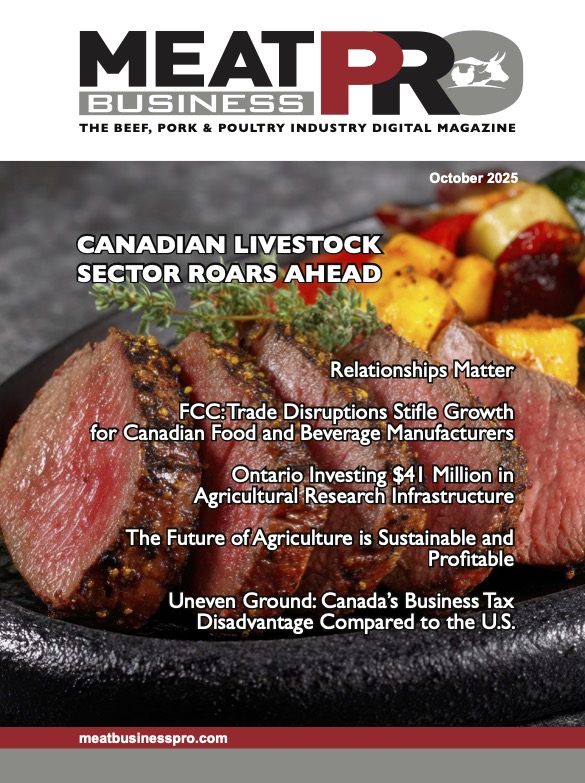Understanding agriculture and food trade: An FCC overview

Canada is a trading nation, especially in agriculture and food, where we grow and produce more than we can consume domestically. In 2019, Canada ranked 5th among global agriculture commodity exporters. Agriculture and food exports combined totalled $67 billion
by Farm Credit Canada
Overall, AAFS estimates that over 50% of Canadian agricultural production is exported directly or processed to be exported. Some commodities such as red meat, cereal grains and pulse crops are very trade dependent. While others, particularly in the supply-managed industries of dairy and poultry, serve the domestic market predominately.
Canada is a major exporter and importer of agriculture and food products. In 2019, we had a surplus in agricultural and food trade of $14.9 billion (food surplus was around $741 million). However, in previous years the food trade was in a deficit when considered in isolation.
“Developing new markets involves establishing relationships with buyers, requiring time, effort and resources.”
Why Canada stands out as an agriculture and food exporter
Our dominant export position is due to our competitiveness and ability to sell high-quality products at an attractive price to foreign buyers. Our endowment in natural resources (water and land) and overall productivity are key drivers of export performance and success.
For example, we can increase export volumes using more production factors (planting more acres, hiring more labour, changing feed rations, etc.). And each option means we can warrant higher expenditures if this output value grows faster than costs. Increasing productivity raises our ability to find success in export markets.
Other variables that businesses sometimes have very little control over also influence success. One example is currency values. Depreciation in Canadian dollar values makes our products more competitive for foreign buyers.
Logistics matter
Generally, ocean bulk freight is less expensive than containerized ocean movement, and both are far more economical than rail freight. However, for medium to long– inland transport, rail is more economical than trucking.
Ocean freight from Canada’s west and east coasts provides relatively inexpensive access to many importing nations. However, Australia still has a clear logistical advantage when selling to China, while Russia has a clear transportation advantage when moving products into much of Europe.
Superior quality, reliable deliveries and customer loyalty also figure into the equation, but transportation costs can loom large. That’s one of the reasons why the U.S. is Canada’s largest trading partner. They’re next door, and the countries share a long, relatively open border.
Market diversification is important
When trade disagreements arise or if a market dries up, it’s important to have alternative customers. There’s an inherent risk of relying too much on one customer or country.
For instance, if anything happened to disrupt the American market for Canadian oats, oat producers, and the grain buyers exporting oats might wish other market opportunities were available. But, it’s difficult to divert product from your best-paying customer to a lower-paying market as insurance against the possibility of market disruption during good times.
The old saying is, ‘Don’t put all your eggs in one basket,’ but developing new markets involves establishing relationships with buyers, and that requires time, effort and resources. It may take initial export success in one market before expanding in other markets. Trade Commissioner Services can provide support to smaller businesses looking to enter new markets.
However, diversification isn’t always feasible – or possible
For example, Canada’s largest food export is baked goods, and 95% of exports go to the U.S. due to proximity and the limited shelf life of these perishable products.
America is also the dominant destination for Canadian hog, beef and red meat exports. However, it’s interesting to note that beef products such as liver, tongue and hides find higher-value markets in other nations such as Japan and South Korea.
Trade agreements open opportunities
The various trade agreements can seem a bit like alphabet soup. There’s CUSMA, the Canada-United States-Mexico trade agreement which replaced NAFTA, the North American Free Trade Agreement.
Recently, Canada has also signed onto CETA, the Comprehensive Economic Trade Agreement with the European Union. Then there’s CPTPP, which is the Comprehensive and Progressive Trans-Pacific Partnership involving eleven signatories: Canada, Japan, Singapore, Australia, Mexico, New Zealand, Brunei, Chile, Malaysia, Peru and Vietnam.
Through the ‘80s and ‘90s, much effort was expended on world trade agreements. While there’s still a World Trade Organization, bilateral and multilateral trade agreements have recently been completed replacing a single agreement covering scores of nations. While the scope of trade agreements that benefit Canadian exporters has expanded, there are other ongoing negotiations or considerations to develop free trade agreements (i.e., United Arab Emirates, Thailand, India, U.K and Caribbean Community)
Reducing tariffs in importing nations is positive for Canadian exports
Trade agreements involve much more than just agriculture and food. The overall purpose is to reduce barriers and facilitate trade. Countries within a trade agreement generally give preferential treatment to each other. This often takes the form of lower tariffs, which makes our exports more competitive relative to another supplier that doesn’t enjoy similar preferential access. Effective tariffs on Canadian exports can be easily retrieved from the Export Development Canada (EDC) Tariff Finder.
Non-tariff trade barriers are increasingly important
Tariffs are not the only policy influencing trade flows. Non-tariff barriers such as sanitary measures and inspection requirements can also play a major role in facilitating or impeding trade. CETA is a good example. Canola imports by the E.U. require environmental impact documentation. Or, the E.U. will only import beef products from certified farms with fully inspected cattle for antimicrobial use.
Maximum residue limits (MRLs) are another example. They vary from country, which introduces uncertainty for exporters. Codex, an international initiative, is meant to do research and provide MRLs that countries can use for their evaluations. Unfortunately, Codex evaluations don’t exist for many chemical compounds, and countries often ignore Codex recommendations even when they do exist. In this way, MRLs can be a non-tariff trade barrier.
Other phytosanitary concerns also have a history of becoming non-tariff trade barriers, including growth promoters used in meat production, weed seeds in grain shipments and trace amounts of non-registered genetically modified grains.
Politics and trade
Most economists believe unrestricted trade contributes to overall wealth because countries tend to produce and export the products where they have a comparative advantage. However, there’s also a push within many countries for food autonomy. They don’t want to rely too heavily on other nations for such a basic human necessity.
Using India as an example
India has millions of farmers, mostly operating on small holdings and struggling to make a living and feed their families. India’s government is often caught balancing its farmer’s needs with food affordability for its large population.
Thus, India sometimes takes measures to limit pulse crop imports, which has a large impact on Canadian lentils and peas.
In 2016, India’s pulse crop imports were worth over $1.1 billion and accounted for over 40% of Canada’s yellow pea and red lentil exports. In 2018, quantitative import restrictions were placed on peas and tariffs on both peas and lentils dramatically reduced trade. Fortunately, a Chinese demand emerged for Canadian peas, and they became the largest export market for the crop.
At around the same time, due to a diplomatic dispute, China cut back on Canadian canola imports, banning sales from a couple of the largest grain companies. Some of the displaced Canadian canola went to Europe for biodiesel production, compensating for reduced European rapeseed production to the United Arab Emirates.
Trade is vital for both exporting and importing nations
Without trade, Canadian agriculture sectors would be dramatically smaller, with a huge loss in economic activity and jobs. And many more countries around the world would struggle to feed their people.
Every commodity relies on different export markets and has different trade nuances. That’s why understanding the trade dynamics for the commodities you produce can be a valuable planning tool.











